This post may contain affiliate links.Please read our disclosure policy.
German cheesecake, known as “Käsekuchen” in Germany, is a creamy quark-based dessert that is popular in Germany and other European countries.

Growing up Käsekuchen was a staple at every family gathering! This simple German cake has a fluffy and light texture and is easy to make from scratch. It is made with quark, a thick soft cheese with a yogurt-like taste that is low in fat and high in protein. It gives this cake a distinct flavor and texture that is different from American-style cheesecake.
I tested this recipe extensively to make sure you can make it with or without quark. Greek yogurt is a perfect alternative if you follow my tips in this post. You also don’t need pudding powder or any other special ingredients and the end result will be perfect without cracks or a long cooling time in the fridge.
German Cheesecake is often served with a dusting of powdered sugar on top but fruit compote or whipped cream also go well with it. It is a perfect cake for any occasion just like our Black Forest Cake, German Apple Cake, German Strawberry Cake, or Apple Strudel.
Why you’ll love this recipe
- Unique flavor and texture – this German dessert is a delicious alternative to the American version and is less sweet.
- Easy and fast to make – Follow my tips for a cheesecake that doesn’t get cracks and doesn’t need to be chilled for hours before you can slice it.
- Simple ingredients – this recipe uses ingredients that you can easily find in your local store, no need to hunt for German vanilla pudding powder or even quark if you follow my tips.
Ingredient notes
Here is an overview of the ingredients you’ll need for this recipe. Scroll down to the recipe card at the bottom for quantities.
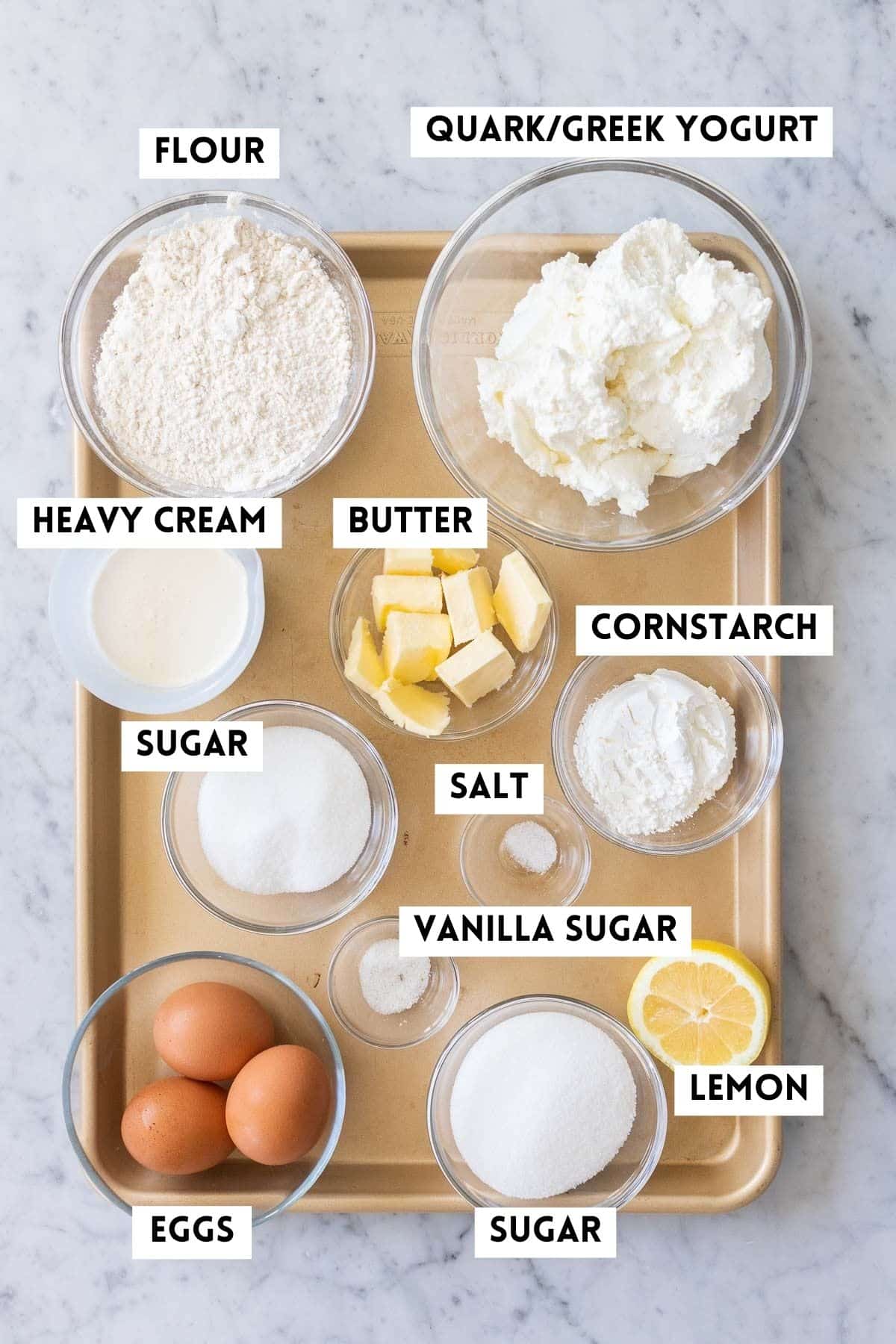
- Quark – Traditionally German cheesecake is made with quark but quark is difficult to find (and expensive) in North America. The best quark to use is very low in fat, in Germany look for Magerstufe. Strained Greek yogurt makes a great alternative. I don’t recommend using ricotta.
- Butter – Use unsalted butter for this cake. The butter should be soft but not melted. If you only have salted butter, leave out the salt in the crust recipe.
- Flour – You need all-purpose flour for the crust, don’t use self-rising flour.
- Eggs – You need large eggs for this recipe. You need one egg for the crust and two for the filling. Make sure when you separate the eggs for the filling that no egg yolk gets into the egg white.
- Vanilla – In Germany, Vanilla sugar is used but you can also use vanilla extract
- Lemon – You need 1 tablespoon of lemon juice, I recommend using freshly squeezed lemon juice for the best taste. Adding a hint of lemon flavor is part of many German baking recipes.
- Heavy cream – Adding whipped heavy cream to the filling makes the cheesecake extra creamy.
- Cornstarch – The cornstarch thickens the filling.
How to make this recipe
Detailed measurements and instructions can be found at the bottom of the page on the printable recipe card.
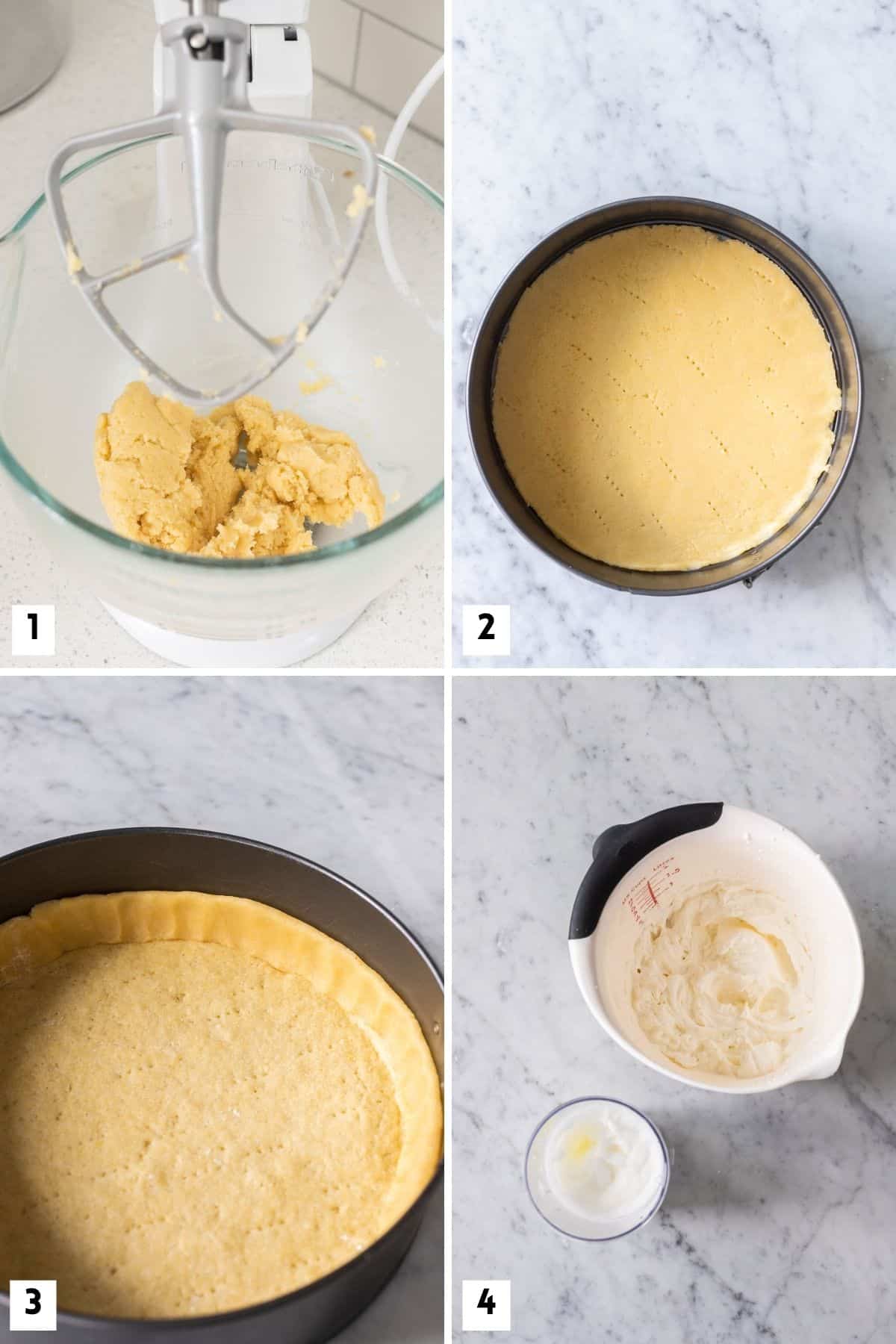
- Make the crust: Preheat the oven to 400 degrees F (200 degrees C). Grease the bottom of a 9-inch springform pan and line it with parchment paper. In the bowl of a stand mixer fitted with the paddle attachment, combine all the ingredients for the crust and mix on medium-high speed until a dough forms.
- Make and pre-bake the bottom crust: On a piece of plastic wrap, roll out 2/3 of the dough into a circle slightly larger than the springform pan and about 1/4 inch thick. Put the springform ring on top and using a knife cut the dough to fit the pan. Transfer it to the pan and prick the bottom multiple times with a fork. Bake the bottom crust (with the sides of the springform attached) for 10 minutes in the lower third of the oven. Take the pan out and let it cool down on a cooling rack. Lower the oven temperature to 320 degrees F (160 degrees F).
- Add the sides: Roll the remaining dough into a long sausage and place it around the sides of the pan. Press the dough about 1 inch up the sides of the pan. Adding the sides after pre-baking the crust keeps it from sliding down while pre-baking.
- Prep filling ingredients: In the meantime, make the cheesecake filling. In a clean bowl of a stand mixer fitted with the whisk attachment whip up the egg whites until soft peaks form, this takes about 3-4 minutes. Then whip the heavy whipping cream until soft peaks form. Set both aside.

- Make the filling: In a large bowl, combine quark, sugar, lemon juice, cornstarch, and egg yolks with a whisk until smooth, don’t overmix the filling. Then fold in egg whites and whipped cream with a spatula.
- Prep for the oven: Transfer the quark mixture to the springform pan and smooth the top with a spatula. Bake in the lower third of the oven for about 70 minutes.
- Finish baking: When the cake is done let it sit for 15 minutes in the turned-off oven with the door slightly ajar, a wooden spoon in the door works well. Then carefully transfer the cheesecake to a cooling rack, slide a knife around the top so the crust doesn’t stick to the ring, and let it cool completely in the pan.
- Serving: You can serve the cake when it is close to room temperature. If you followed all my tips it is safe to cut into it even if it is still slightly warm.
Expert tips for success
- Quark substitutes: German cheesecake is traditionally made with quark. If quark is not available, you can substitute it with strained Greek yogurt. In my experience, ricotta is not a good substitute because it often makes the cheesecake grainy.
- Greek Yogurt: I recommend straining your Greek yogurt. It often has a lot of extra liquid (called whey). Strain it for a few hours or overnight in a sieve lined with cheesecloth before using it. A 32 oz container of Greek yogurt works best and results in about 20-23 oz of strained yogurt. Use 2 heaping cups for this recipe.
- Mixing: Be sure to mix the filling with a whisk or on low speed to avoid incorporating too much air. Overmixing can cause the cheesecake to rise and then collapse, resulting it in splitting open in the middle.
- Use room temperature ingredients: Let the quark and eggs come to room temperature before using them in this recipe. This will help ensure the best texture and consistency.
- Prepare the crust correctly: Press the crust only halfway up the sides of the pan. You want the filling to rise higher than the crust.
- Cool the cheesecake slowly: Allow the cheesecake to cool gradually by letting it sit in the oven for 15 more minutes with the door slightly open. Then let it cool at room temperature completely before removing the springform pan ring. You can slice and serve it without cooling it in the fridge.
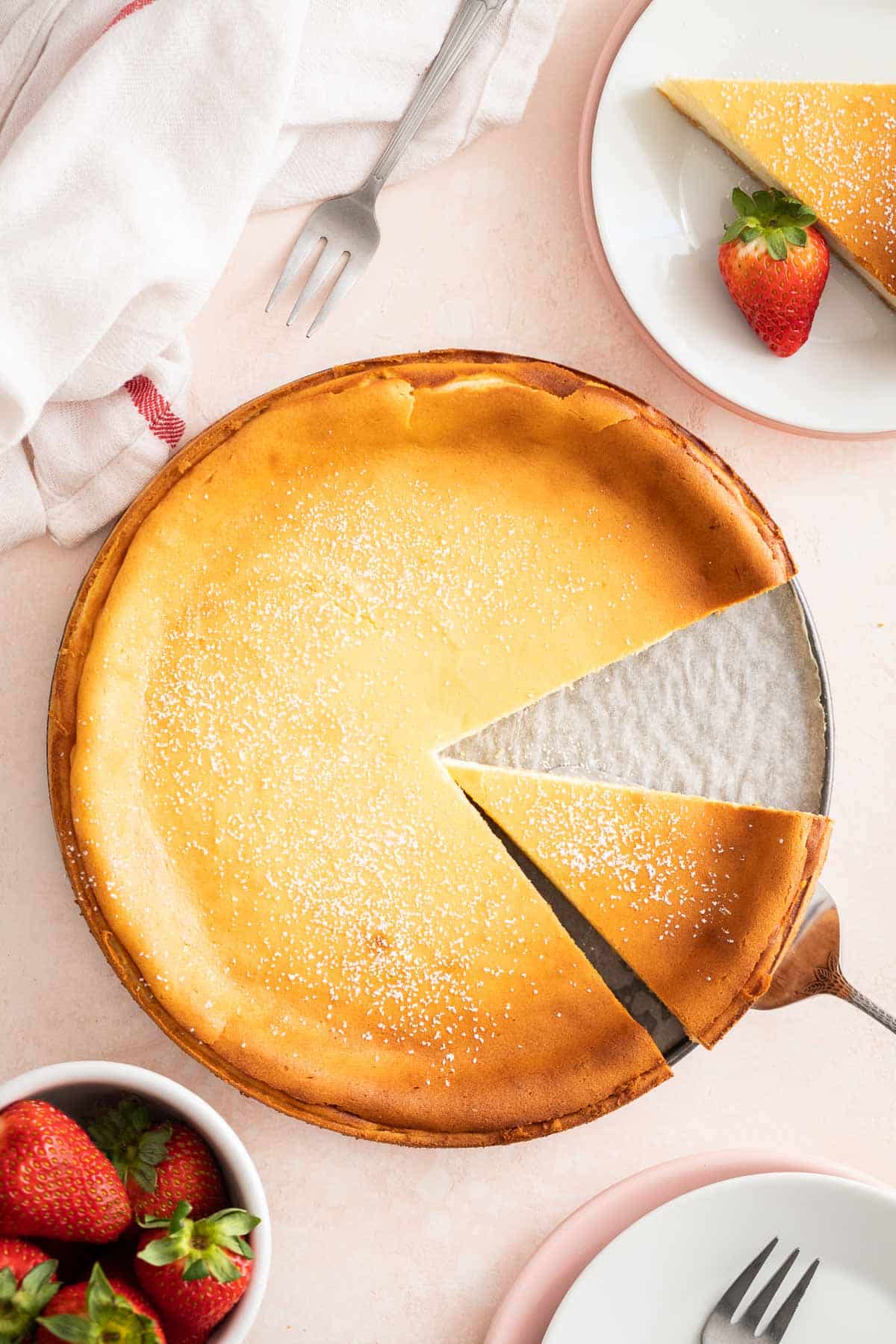
Recipe FAQs
German cheesecake is made with quark, has a more fluffy texture, and is less sweet than American cheesecake which is made with cream cheese, has a smoother texture, and is sweeter. The crust for German version is usually made from shortbread dough, while American version typically has a graham cracker crust.
Quark is a type of fresh dairy product that is similar in texture to ricotta cheese or Greek yogurt and has a tangy flavor. It is a thick soft cheese with a yogurt-like taste that is low in fat and high in protein. Quark is popular in many European countries, including Germany, where it is commonly used as an ingredient in desserts like German cheesecake.
Many German cheesecake recipes result in the cake cracking after it is baked. But there are some simple tricks to prevent this. The higher the cheesecake the more prone to cracking it is. A very wet and airy filling can also be a problem. That’s why I recommend straining the Greek yogurt so it is more similar to quark and whipping the heavy cream before adding it. Baking the cake at a low temperature and letting it sit in the turned-off oven also helps a lot. Sudden temperature changes can cause the top cake to break. If you still end up with a not-perfect cheesecake, just sprinkle some powdered sugar on top or add some fresh fruit.
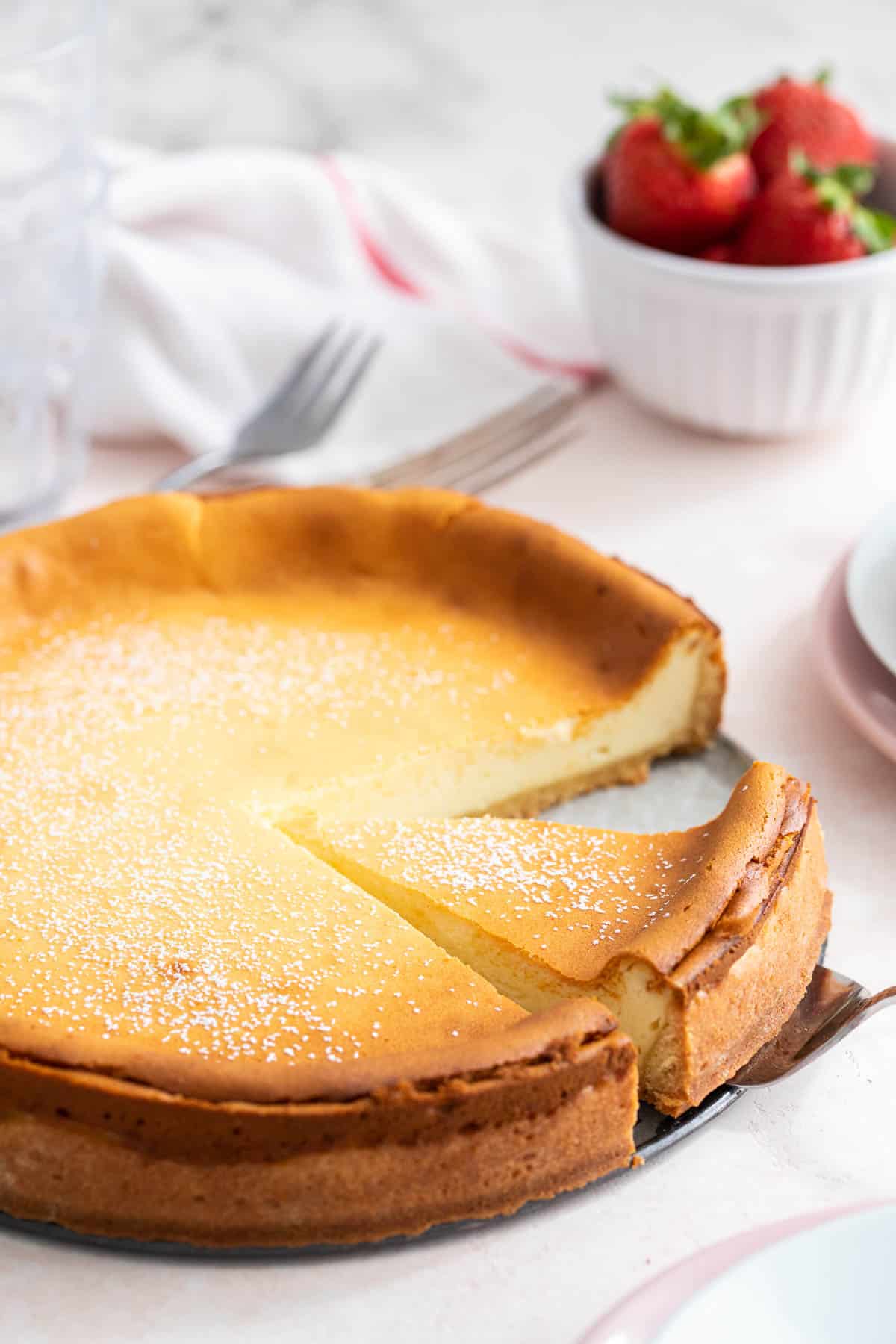
Popular Add-ins and variations
- Raisins or Sultanas: Sprinkle 1/3 cup of raisins on the prebaked crust before adding the filling.
- Streusel topping: Adding some streusel on top is a delicious way to add some crunch. Combine 100g all-purpose flour, 75 g sugar, 1 tsp vanilla sugar or extract, and 75 g softened butter with a hand mixer or in the bowl of a stand mixer fitted with the paddle attachment, and mix until crumbly. Sprinkle on top of the cheesecake before baking.
- Canned mandarin oranges, cherries, or other fruit: Carefully add 1/2 cup of well-drained fruit or berries to the filling.
- Fresh fruit topping: Adding some fresh fruit like strawberries after baking similar to my German Strawberry cake is also popular in Germany.
If you are looking for a larger Kaesekuchen check out my Cheesecake Bars recipe. It’s a popular variation of German cheesecake made on a baking sheet.
Serve it with
I usually serve my German cheesecake with a dusting of powdered sugar but some homemade whipped cream on the side is also an option. This cake also tastes great with fresh berries like strawberries or raspberries or other fruit on the side.
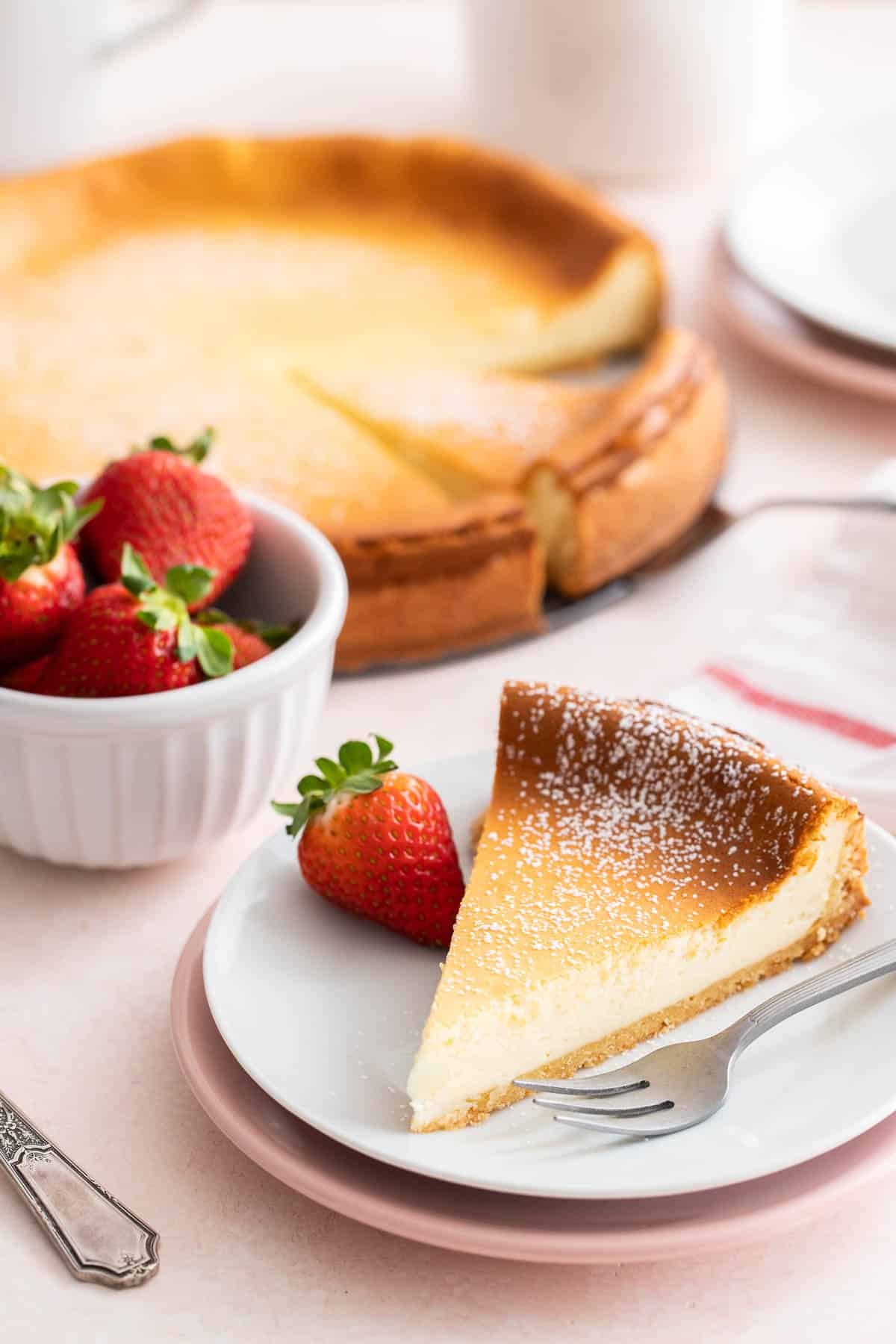
Storage Instructions
Käsekuchen keeps for 2-3 days in the fridge. Make sure to cover it well with plastic wrap or use a cake dome. I don’t recommend freezing this cake because the texture will change and it will become grainy.
More German Recipes to Try
Cakes
German Plum Cake
German Recipes
Kaiserschmarrn
Cookies, Brownies & Bars
Nut Corners (German Nussecken)
Never Miss A Recipe! Subscribe to my newsletter and follow along on Facebook, Instagram, and Pinterest for more great recipes and all of the latest updates.
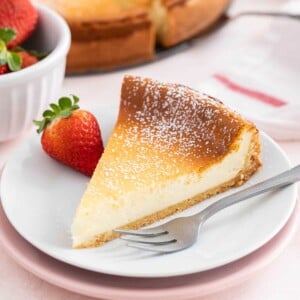
German Cheesecake
Equipment
Ingredients
For the crust:
- 1 ¼ cup all-purpose flour
- ⅓ cup sugar
- 1 tsp vanilla sugar, or vanilla extract
- ¼ tsp salt
- 1 large egg
- 5 Tbsp unsalted butter, softened
For the cheesecake:
- 2 large eggs, divided
- ¾ cup whipping cream
- 17.6 oz quark, or strained Greek yogurt (note 1)
- 1/2 cup sugar
- 1 Tbsp lemon juice
- ¼ cup cornstarch
Instructions
- Preheat the oven to 400 degrees F (200 degrees C). Grease the bottom of a 9-inch springform pan.
- Make the crust. In the bowl of a stand mixer fitted with the paddle attachment, combine all the ingredients for the crust and mix on medium-high speed until a dough forms. Roll out 2/3 of the dough to line the bottom of the pan (sides will be done later). Prick the bottom multiple times with a fork. Then bake the bottom crust (with the sides of the springform attached) for 10 minutes in the lower third of the oven.
- Take the pan out and let it cool down on a cooling rack. Lower the oven temperature to 320 degrees F (160 degrees F).
- Roll the remaining dough into a long sausage and place it around the sides of the pan. Press the dough about 1 inch up the sides of the pan.
- Make the cheesecake filling. Divide the eggs. In a clean bowl, whip the egg whites until soft peaks form. Set aside. Then make whipped cream. In a large bowl, combine quark, sugar, lemon juice, cornstarch, and egg yolk until smooth. Fold in whipped cream and egg whites.
- Transfer the cheesecake filling to the springform pan and smooth the top. Bake in the lower third of the oven for about 70 minutes.
- When the cheesecake is done let it sit for 15 minutes in the turned-off oven with the door slightly ajar. Then carefully transfer the cheesecake to a cooling rack and let it cool completely in the pan.
Notes
- Quark substitutes: German cheesecake is traditionally made with quark. If quark is not available, you can substitute it with strained Greek yogurt. In my experience, ricotta is not a good substitute because it often makes the cheesecake grainy.
- Greek Yogurt: I recommend straining your Greek yogurt. It often has a lot of extra liquid (called whey). Strain it for a few hours or overnight in a sieve lined with cheesecloth before using it. A 32 oz container of Greek yogurt works best and results in about 20-23 oz of strained yogurt. Use 2 heaping cups for this recipe.
- Mixing: Be sure to mix the cheesecake batter with a whisk or on low speed to avoid incorporating too much air. Overmixing can cause the cheesecake to rise and then collapse, resulting in cracks.
- Use room temperature ingredients: Let the quark and eggs come to room temperature before using them in this recipe. This will help ensure the best texture and consistency.
- Prepare the crust correctly: Press the crust only halfway up the sides of the pan. You want the filling to rise higher than the crust.
- Cool the cheesecake slowly: Allow the cheesecake to cool gradually by letting it sit in the oven for 15 more minutes with the door slightly open. Then let it cool at room temperature completely before removing the springform pan ring. You can slice and serve it without cooling it in the fridge.
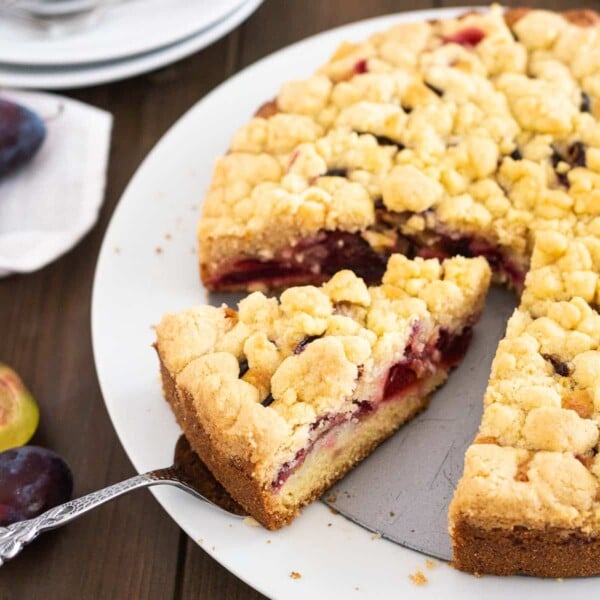
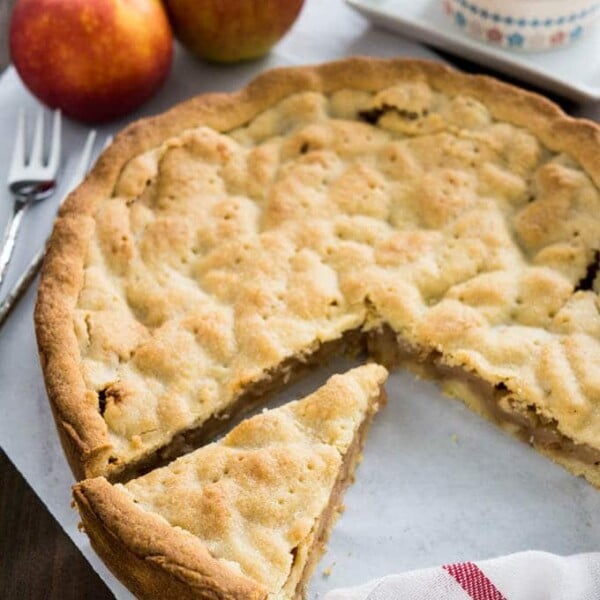
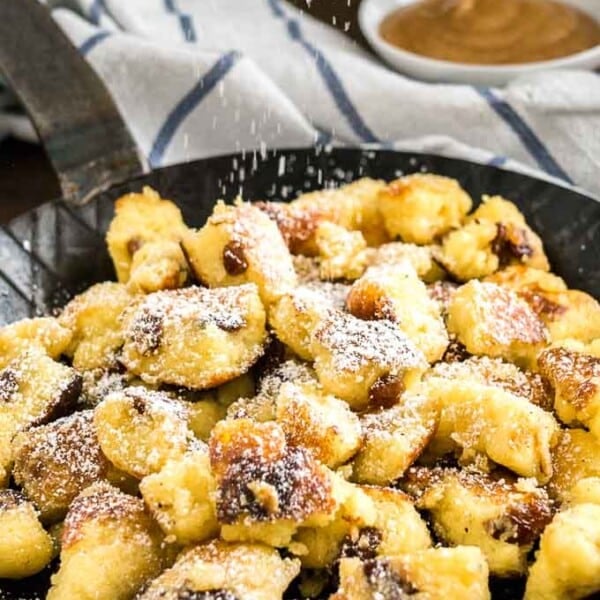
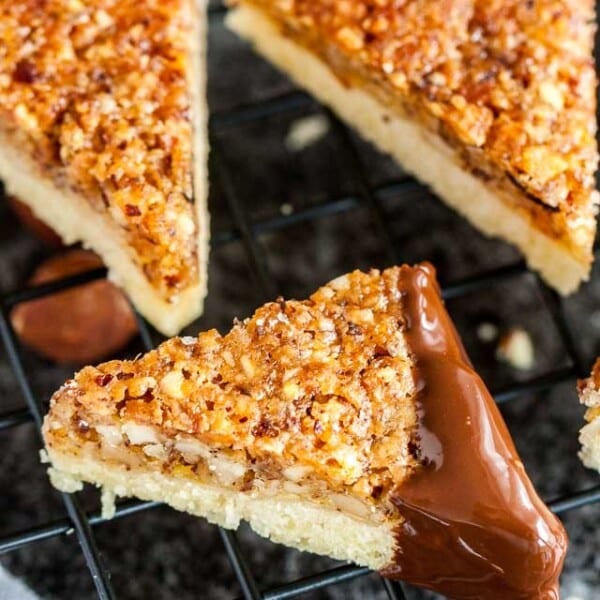
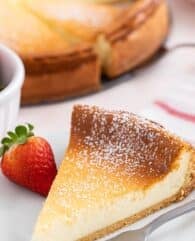
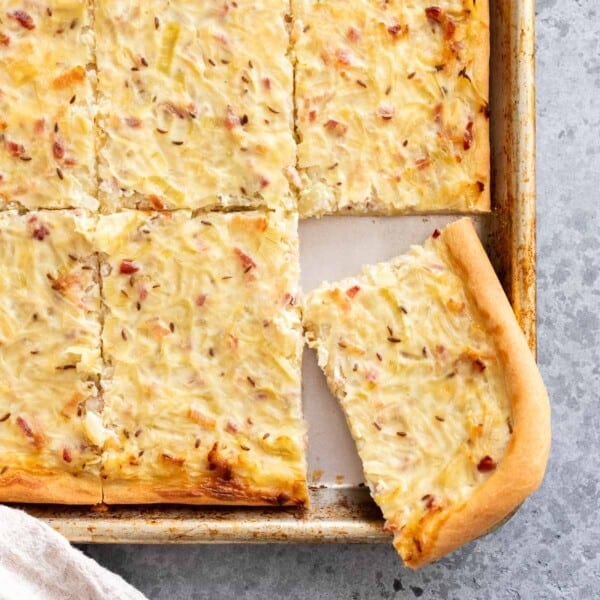
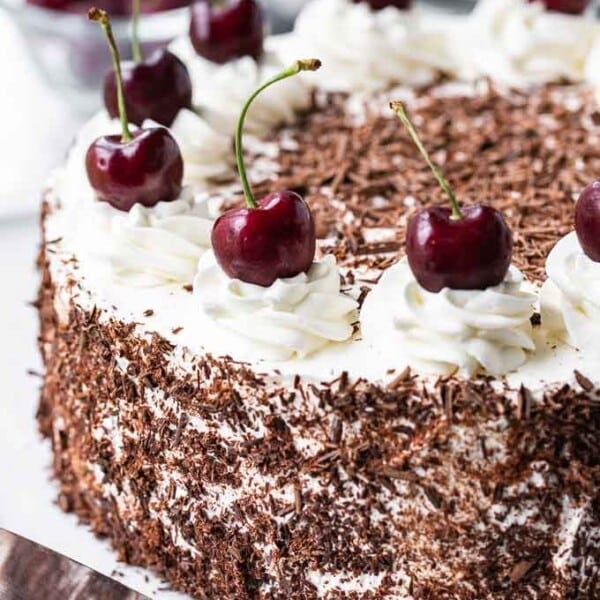
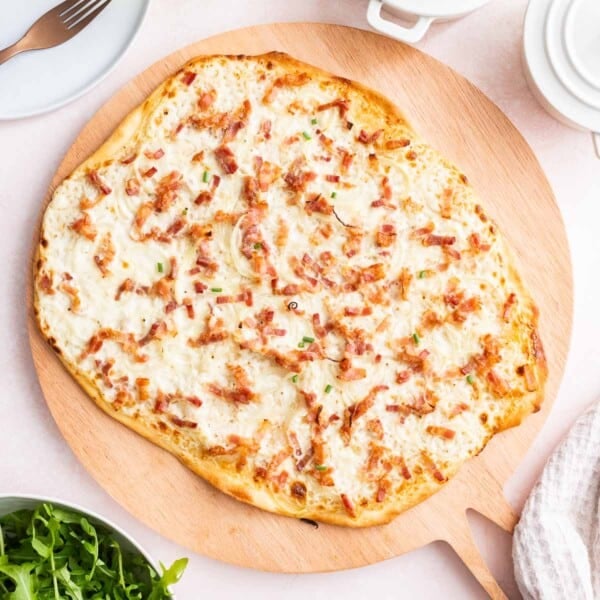
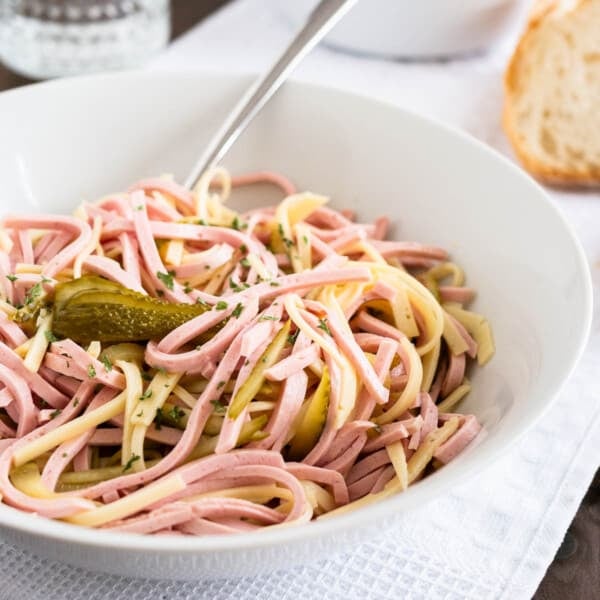






Hi, do you use granulated white sugar? And have you tried using golden caster sugar or just brown sugar?
Yes, granulated white sugar is what I use in this recipe. Brown sugar is not a thing in Germany, so if you want to go for authentic taste, I recommend sticking with white sugar.
Made this cheesecake for my 90 year old father who hadn’t had it since he was child. He remembers his German grandmother making it and he was thrilled with this recipe. I used Greek yogurt and the only thing I would change next time is to use some lemon zest for more lemon tang. It was super easy and a huge hit! Also pleased with the low amount of sugar – great recipe
Can you make this recipe without the crust? If not, how could I make this recipe Gluten Free?
Thank you!
I made this for a friend’s Christmas party. The tips and information was very helpful, thank you! The cake turned out great! I used strained 0% fat greek yogurt and vanilla extract. I added lemon zest to the crust for more lemon flavour and also added vanilla to the yogurt mixture. Great reviews from everyone. I did find it needed longer in the oven, this may have been because I didn’t have the yogurt quite at room temperature.
Is this good to make same day serving or cannot be done the day before? Thanks!
You can make this cake the day before and refrigerate it overnight.
Hi Julia! Can I use Dr oetker pudding mix instead of cornstarch in this?
Thanks!
Yes, I think you could. I haven’t tried it but it should work.